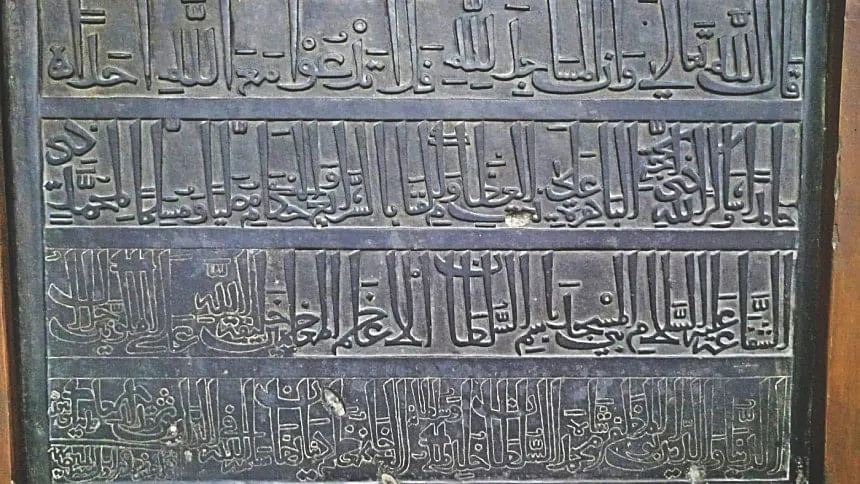The inscriptions produced during the Mughal period were no less master pieces than their architectural marvels exhibited in the fine royal building and garden constructions.
The best calligraphy specimen can be seen in the shape of manuscripts produced during Mughal Period across the entire dominion.
The writing styles reflected on their coins and their engraved inscriptions are no less amazing while the calligraphy patterns adopted by them for their vast coinages and on few epigraphs had a very deep influence on the rulers who came after them and followed their predecessors.
The Durrani and Sikh period coins and epigraphs too exhibit the Mughal style of writing and engravings.
Mughal calligraphy
Mughals are believed to have promoted ‘Naskh’ and ‘Nastaliq’ patterns of calligraphy. In the words of Abul Fazal, the Mughal emperors, Akbar and Jahangir promoted the ‘Nastaliq’ or the ‘Round Persian’ characters.
Providing a brief description of various calligraphic patterns used during Mughal Period in India and Central Asia, he writes that Suls, Naskh, Tanqi, Riqa, Muhaqqaq, Raihan, Taliq, styles of writing were commonly used in entire Mughal dominion which included the land of Jammu and Kashmir
The general scripts adopted in Kashmir, as recorded by Diwan Kirpa Ram in his Gulzari Kashmir were either in Arabic or in Persian. The styles were Kufi, Naskh, Makramat Suls, Riqa and Raihan in Arabic and Nastaliq Shikast, Gular, Nakhan Shikast, Aniz and Shaifa in Persian.
Despite various calligraphy styles, Mughals are known to have promoted their writing mechanism mostly in the Round Persian character called Nastaliqe, such specimen can be observed on a number of copper, silver and gold coins of Akbar, Jahangir and Shah Jahan and on historic Mughal Period inscriptions at the arcade of Verinag spring, at the gate of Kathi Darwaza of Kohimaran Rampart and at other scores monuments of Mughal era.
Famous calligraphers
In fact this art was introduced during Shahmeri period, and it flourished during Mughal period. Mughals appointed several reputed writers and calligraphers and honoured them as well.
Mohammad Hussain Kashmiri, reputed calligraphist who served as one of the courtiers of Akbar was honoured with the title of Zarin-Qalam (Golden Pen). Mohammad Hussain Kashmiri, writes Abul Fazil, surpassed his Master Maulana Abdul Aziz by his handsome pen. Ali Chaman, was another noted court calligraphist of Akbar.
Mohammad Murad Kashmiri was given the title of “Shirin Qalam” (the sweet pen) by his master, Shah Jahan. Several Kashmiri artists got patronage in Durrani courts.
Bawani Dass-Katchro was the court calligrapher in Durrani darbar. Gradually, this art from Shahi darbars flourished towards towns and rural areas. Certain families adopted it as their main profession and promoted it further.
Promotion of calligraphy
It was because of this popularity of calligraphy art in Kashmir, that Kashmir possesses a rich repository of manuscripts and epigraphs in various calligraphy styles. We have there a number of manuscripts in various official and non-official collections in Nastaliq and Nask styles.
During the modern ages the Urdu press, Urdu, Persian and Arabic book writers played a vital role in promotion of calligraphy skill. The academy of art, culture and languages had also been conducting calligraphy learning classes for the last several years.
The academy has also been taking care of olden manuscripts exhibiting wonderful styles of calligraphy art. Beside the Cultural Academy, Research libraries, Archives, and other private and government institutions have been taking care of hundreds of manuscripts and several epigraphs.
Disclaimer: The views and opinions expressed in this article are the personal opinions of the author.
The facts, analysis, assumptions and perspective appearing in the article do not reflect the views of GK.







